Page 430 - IJB-10-6
P. 430
International Journal of Bioprinting 3D-bioprinted respiratory disease model
Figure 8. Live/dead stained montage images of infected 3D constructs and a mock infection cultured in dynamic conditions: (A) 6 HPI, (B) 24 HPI, (C)
48 HPI, and (D) mock 48 HPI.
alginate/gelatin/collagen solution was highly compatible the biocompatibility of alginate-based bioinks, making
with 3D printing for tissue engineering applications. it a useful addition even in low concentrations. As
45
While the viscosity of the solution containing a relatively the ink was able to be printed before crosslinking in an
high percentage of alginate (5%) and gelatin (5%) was ionic crosslinking bath, a high degree of printability was
increased over previous studies utilizing alginate/collagen maintained, regardless of whether the ink contained 4 µg/
inks, 33,34 the thermal responsiveness of gelatin and shear- mL of nanoparticles, consistent with previously reported
thinning behavior of alginate allowed for printing at results. As the culture media used consisted of 20 mM
33
reasonable pressures, resulting in high cell viability CaCl , which acts as the ionic crosslinking, mechanical
2
post-printing. While low, the addition of collagen has stability was generally maintained. However, as 20% of mass
previously been identified as having a positive impact on loss still occurred over the 28-day period, it is hypothesized
Volume 10 Issue 6 (2024) 422 doi: 10.36922/ijb.3895

